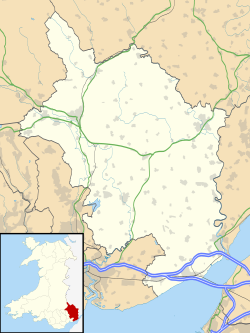Cwmyoy
| |
|---|---|
 Cwmyoy, on the slope of Hatterrall Hill | |
Location within Monmouthshire | |
| OS grid reference | SO299232 |
| Principal area | |
| Preserved county | |
| Country | Wales |
| Sovereign state | United Kingdom |
| Post town | ABERGAVENNY |
| Postcode district | NP7 |
| Dialling code | 01600 |
| Police | Gwent |
| Fire | South Wales |
| Ambulance | Welsh |
| UK Parliament | |
| Senedd Cymru – Welsh Parliament | |
Cwmyoy is an extensive rural parish in Monmouthshire, Wales (Welsh : Cwm Iou, for the valley and parish; Welsh : Cwm-iou, for the village). The standard Welsh name is Cwm Iau or Cwm-iau. In the Gwentian dialect of Welsh that was spoken here until the late 1800s, the name was pronounced as Cwm Iou ('ou', also spelt informally 'oi', for standard 'au' is a common feature of south Wales Welsh). The 'English' name is in fact this local dialect form in a more English spelling. The name of the valley probably originates from the Welsh word iau meaning yoke, in reference to the shape of the hill surrounding it. [1]
Contents
The village of Cwmyoy is 7 miles (11 km) north of Abergavenny and 4 miles (6.4 km) south of Llanthony in the Vale of Ewyas in the Black Mountains. It is within the Brecon Beacons National Park, in an upland location just below the broad ridge of Hatterrall Hill, which carries the Wales–England border and Offa's Dyke Path.

